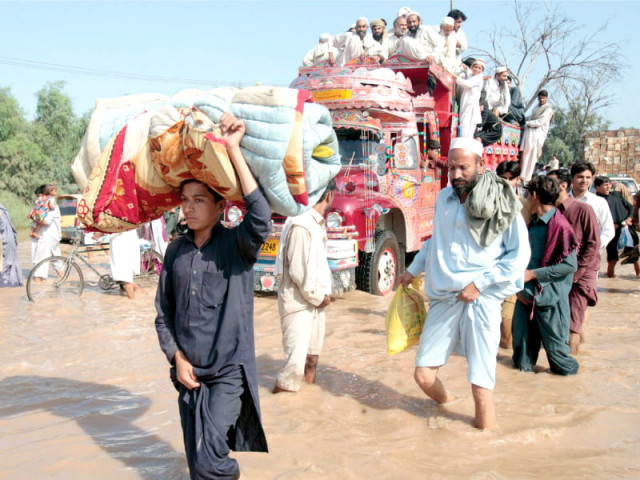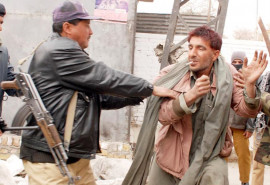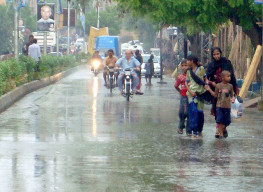
Despite the provincial government’s claims about providing relief, there seems to be no respite for people living rain-affected regions. Though the military has initiated efforts to battle potential hazards, many people are fending for themselves as corpses festering in stagnant water threaten to cause deadly epidemics.
Stagnant rainwater in the worst-hit districts, including Sukkur, Ghotki, Shikarpur, Jacobabad, Kashmore, Larkana and Khairpur, has yet to be pumped out. According to reports, Tawangi, a town in Jacobabad, is completely submerged under about six feet of water. The damage that the downpour has wrought on the town cannot be assessed since access to the area is difficult.
Downhill torrents from Balochistan have inundated three union councils of Thull and breaches occurred in many watercourses, adding to the miseries of the marooned.
Residents of Gulanpur, a union council in Kashmore, are still seeking help from the district’s administration, which they claim is nowhere in sight. Around 18 people have been reportedly died in different dehs of Gulanpur. According to the official survey, two high schools, three middle schools and dozens of primary schools in the union council have been damaged. At least 3,000 katcha houses have collapsed and 1,000 pacca houses have been partially damaged in the union council. Paddy crop sown over more than 700,000 acres in Gulanpur have been destroyed completely.
Stagnant water has caused the spread of gastroenteritis among children and if no measures are taken, an epidemic could spread in the area. There were reports that about a 100 new cases of the disease sprang up in Khairpur on Thursday. There have also been cases of skin diseases and a rise in the incidence of malaria, but the exact figure is unclear since a comprehensive survey has yet to be conducted. There were reports that around 800 people in Jacobabad visited hospitals to have waterborne diseases treated.
Breaches have occurred in Gehno shakh, Tangwani shakh and Lundi shakh. As a result, three union councils, Saeedokot, Sher Wah and Thull Purano, became submerged and the gushing water is heading towards Thull town. A woman, Kazbano Lashari, was washed away with the strong current of water in Saeedokot.
More than 30,000 residents of the three union councils are homeless, as the strong currents damaged houses and huts in more than 200 villages. Approximately ten kilometers of railway track near Thull has been inundated and train service has been suspended. Rainwater has also accumulated in many parts of Qamber, including, Barkat Shah Muhalla, Chandio Muhalla, Gopang Muhalla, Brohi Muhalla.
Downhill torrents from Kirthar Range are putting tremendous pressure on the Flood Protection Bund. A part of the bund near Ghaibi Dero developed fractures on Thursday and water started seeping out. Villagers rushed to the spot and plugged the cracks.
Relief efforts
Earlier, Chief Minister Qaim Ali Shah took a two-day tour of upper Sindh and announced Rs25 million as relief funds for each affected district. He also asked districts’ administrations to take all-out measures to provide relief, but it seems that his instructions have fallen on deaf ears. Bodies and dead animals are floating in the stagnant rainwater, posing a health hazard to the stranded people who are desperate for help.
A meeting on the relief measures was to be held on Thursday at Chief Minister House, but was postponed as Shah had his hands full with the fire that broke out in the Ali Enterprises factory in Baldia two days ago.
Though the government’s efforts to provide relief might be sluggish, troops from the Pakistan Army have already jumped into action. It has deployed over 1,000 soldiers to rescue people from the worst-hit areas and pump out stagnant water. So far, it has evacuated 3,681 people to safer places on MI-17 and boats.
Air Chief Marshal Tahir Rafique Butt, Chief of the Air Staff, Pakistan Air Force (PAF) flew over the flood affected areas of Jacobabad to survey the extent of the damage. He asked the PAF Disaster Management Cell at the Air Headquarters, Southern Air Command, to begin relief activities. PAF’s air transport, including the helicopter fleet, is also standing by and can be used whenever required by National Disaster Management Authority.
Published in The Express Tribune, September 14th, 2012.


















COMMENTS
Comments are moderated and generally will be posted if they are on-topic and not abusive.
For more information, please see our Comments FAQ